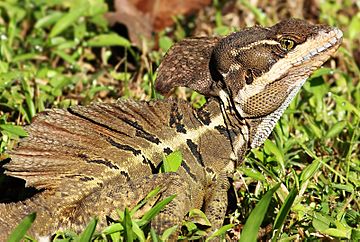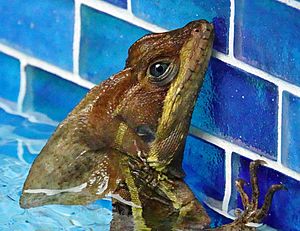Basilisks facts for kids
Quick facts for kids Basilisks |
|
|---|---|
 |
|
| Brown basilisk, Basiliscus vittatus, Costa Rica | |
| Scientific classification |
|
| Kingdom: | Animalia |
| Phylum: | Chordata |
| Class: | Reptilia |
| Order: | Squamata |
| Suborder: | Iguania |
| Family: | Corytophanidae |
| Genus: | Basiliscus Laurenti, 1768 |
| Species | |
|
Four, see text. |
|
Basilisks are a group of large lizards found in southern Mexico, Central America, and northern South America. There are four types, or species, of basilisks. They are often called the "Jesus Christ lizard" because they can run across the surface of water. They do this for short distances before they start to swim.
Contents
What's in a Name? The Basilisk's Story
The name Basiliscus and the common name "basilisk" come from the Greek word basilískos. This word means "little king." The name vittatus means "striped" in Latin. It was given by Carl Linnaeus in his famous book, Systema Naturae.
How Big Do Basilisks Get?
Basilisks usually grow to be about 70 to 75 centimeters (27 to 30 inches) long. This measurement includes their long tail. They grow quickly when they are young. Their growth slows down as they get older. Basilisks have special crests that look like sails on their head, back, and tail. These crests make them look a bit like ancient dinosaurs. Basilisks shed their skin in small pieces as they grow.
How Do Basilisks Run on Water?
Basilisks are famous for their amazing ability to run on water. This is why they are called "Jesus Christ lizards." They can run on two legs across the water's surface. They can run about 1.5 meters (5 feet) per second for about 4.5 meters (15 feet). After that, they drop to all fours and start swimming.
They have special flaps of skin between their toes. These flaps spread out when they hit the water. This creates a larger surface area. It also traps small pockets of air. This helps them stay on top of the water. They can even use all four legs to "walk" on water for a bit longer. Other lizards, like sailfin lizards, can also run on water.
Other Ways Basilisks Stay Safe
Basilisks have other ways to protect themselves. They can quickly dig into the sand to hide from animals that want to eat them. They have special muscles around their nostrils. These muscles close up to stop sand from getting into their nose.
Where Do Basilisks Live?
Basilisks live in the warm, wet tropical rain forests of Central and South America. You can find them from southern Mexico all the way down to Ecuador and Venezuela.
Basilisks in New Places
The brown basilisk (Basiliscus vittatus) has been found in Florida, USA. It was not originally from there. This lizard has learned to live in Florida's colder winters. It burrows into piles of leaves to stay warm. Brown basilisks have been seen as far north as Fort Pierce. They are also common in cities like Boca Raton in Palm Beach County.
Types of Basilisks
There are four main species, or types, of basilisks in the Basiliscus genus:
- Basiliscus basiliscus – common basilisk
- Basiliscus galeritus – red-headed basilisk
- Basiliscus plumifrons – plumed basilisk
- Basiliscus vittatus – brown basilisk or striped basilisk
Meet the Basilisk Species
| Image | Scientific Name | Common Name | Where They Live |
|---|---|---|---|
 |
Basiliscus basiliscus | Common Basilisk | From southwestern Nicaragua to northwestern Colombia (Pacific side), and from central Panama to northwestern Venezuela. |
 |
Basiliscus galeritus | Western Basilisk or Red-Headed Basilisk | Western Colombia and western Ecuador. |
 |
Basiliscus plumifrons | Plumed Basilisk, Green Basilisk, or Double Crested Basilisk | Eastern Honduras, through Nicaragua and Costa Rica, to western Panama. |
 |
Basiliscus vittatus | Brown Basilisk or Striped Basilisk | Mexico, Central America, and nearby northwestern Colombia. |
See also
 In Spanish: Basilisco (criatura mitológica) para niños
In Spanish: Basilisco (criatura mitológica) para niños


